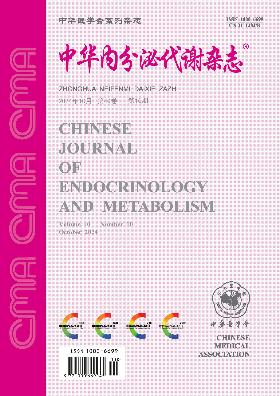Association between bilirubin levels and diabetic retinopathy in type 2 diabetes mellitus
Q4 Medicine
引用次数: 0
Abstract
Objective To investigate the correlation between serum bilirubin level and the risk of diabetic retinopathy (DR) in patients with type 2 diabetes mellitus of different sexes. Methods A total of 1 304 patients with type 2 diabetes mellitus were included in this study. The clinical data were collected and fundus examination was performed. According to the results of fundus examination, the patients were divided into DR group and Non-DR (NDR) group. The correlation between the levels of serum total bilirubin, direct bilirubin, indirect bilirubin, and the occurrence of DR was analyzed. Results The levels of total bilirubin, direct bilirubin, and indirect bilirubin in DR group were significantly lower than those in NDR group. Univariate analysis showed that the levels of total bilirubin and indirect bilirubin were negatively correlated with the occurrence of DR (P<0.01). There was no significant correlation between the level of direct bilirubin and the occurrence of DR. Smooth curve fitting showed that there was a U-shaped relationship between the levels of total bilirubin and indirect bilirubin and the risk of DR in women, while a negative correlation between total bilirubin, indirect bilirubin and the risk of DR in men. The results of multiple regression analysis showed that in men total bilirubin increased by 1 μmol/L, the risk of DR decreased by 8% (OR=0.92, 95%CI 0.88-0.98, P<0.01). Indirect bilirubin increased by 1 μmol/L, and the risk of DR decreased by 9% (OR=0.91, 95%CI 0.84-0.96, P<0.01). In women, when total bilirubin<12.8 μmol/L, for every 1 μmol/L increase in total bilirubin, the risk of DR decreased by 17%(OR=0.83, 95%CI 0.72-0.95, P<0.01); When total bilirubin≥12.8 umol/L, for every 1 μmol/L increase in total bilirubin, the risk of DR increased by 10%(OR=1.10, 95%CI 1.01-1.20, P<0.05); When indirect bilirubin<9.8 μmol/L, for every 1 μmol/L increase in indirect bilirubin, the risk of DR decreased by 20%(OR=0.80, 95%CI 0.68-0.94, P<0.01); When indirect bilirubin≥9.8 μmol/L, for every 1 μmol/L increase in indirect bilirubin, the risk of DR increased by 13%(OR=1.13, 95%CI 1.01-1.25, P<0.05). Conclusion This study shows that there is a U-shaped relationship between the levels of total bilirubin and indirect bilirubin and the risk of DR in female patients with type 2 diabetes mellitus, and there is a negative correlation between total bilirubin, indirect bilirubin and the risk of DR in male patients. However, there was no significant correlation between direct bilirubin and DR risk. Key words: Diabetes mellitus, type 2; Diabetic retinopathy; Bilirubin胆红素水平与2型糖尿病视网膜病变的关系
目的探讨不同性别2型糖尿病患者血清胆红素水平与糖尿病视网膜病变(DR)风险的相关性。方法本研究共纳入1304例2型糖尿病患者。收集临床资料,进行眼底检查。根据眼底检查结果,将患者分为DR组和非DR组。分析血清总胆红素、直接胆红素、间接胆红素水平与DR发生的相关性。结果DR组总胆红素、直接胆红素和间接胆红素水平均显著低于NDR组。单因素分析显示,总胆红素和间接胆红素与DR的发生呈负相关(P<0.01),直接胆红素与DR发生无显著相关性。平滑曲线拟合显示,女性总胆红素和间接胆红素水平与DR风险呈U型关系,男性总胆红素、间接胆红素与DR风险呈正相关。多元回归分析结果表明,男性总胆红素升高1μmol/L,DR发生风险降低8%(OR=0.92,95%CI 0.88-0.98,P<0.01),DR风险降低17%(OR=0.83,95%CI 0.72-0.95,P<0.01);当总胆红素≥12.8μmol/L时,总胆红素每增加1μmol/L,DR风险增加10%(OR=1.10,95%CI 1.01-1.20,P<0.05);当间接胆红素<9.8μmol/L时,间接胆红素每增加1μmol/L,DR风险降低20%(OR=0.80,95%CI0.68-0.94,P<0.01);当间接胆红素≥9.8μmol/L时,间接胆红素每增加1μmol/L,DR风险增加13%(OR=1.13,95%CI 1.01-1.25,P<0.05),男性患者总胆红素、间接胆红素与DR风险呈负相关。然而,直接胆红素与DR风险之间没有显著相关性。关键词:糖尿病,2型;糖尿病视网膜病变;胆红素
本文章由计算机程序翻译,如有差异,请以英文原文为准。
求助全文
约1分钟内获得全文
求助全文
来源期刊

中华内分泌代谢杂志
Medicine-Endocrinology, Diabetes and Metabolism
CiteScore
0.60
自引率
0.00%
发文量
7243
期刊介绍:
The Chinese Journal of Endocrinology and Metabolism was founded in July 1985. It is a senior academic journal in the field of endocrinology and metabolism sponsored by the Chinese Medical Association. The journal aims to be the "Chinese broadcaster of new knowledge on endocrinology and metabolism worldwide". It reports leading scientific research results and clinical diagnosis and treatment experience in endocrinology and metabolism and related fields, as well as basic theoretical research that has a guiding role in endocrinology and metabolism clinics and is closely integrated with clinics. The journal is a core journal of Chinese science and technology (a statistical source journal of Chinese science and technology papers), and is included in Chinese and foreign statistical source journal databases such as the Chinese Science and Technology Papers and Citation Database, Chemical Abstracts, and Scopus.
 求助内容:
求助内容: 应助结果提醒方式:
应助结果提醒方式:


